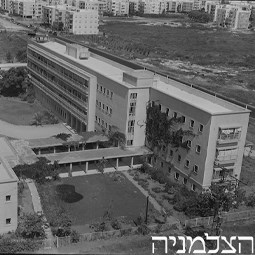About the Collection
The Eretz Yisrael collection began to coalesce in the beginning of 1936, immediately after Weissenstein's arrival in the county. The Fifth Aliyah was, at that point, reaching the end of its first stage, and Rudi Weissenstein hastily documented the accelerated urban development of Tel Aviv and the Yishuv – from small business initiatives to the establishment of large cultural and scientific undertakings. With the breakout of the Arab rebellion during the spring of that year, the development of a national infrastructure began. Weissenstein documented the establishment of the Tel Aviv port and the Reading power station. In addition, he faithfully documented the new agricultural movement during the time that he worked for Keren Hayesod and the Jewish National Fund and other similar, large institutions.
The collection's richness is derived from its wide range of subjects. Weissenstein didn't refrain from producing professional photography, such as architectural, fashion and music photography. He also photographed for the Mandate powers, the British Army and courts. In addition to his documentation of Tel Aviv, his curious and loving eye was also turned on the land as a whole as he traveled its lengths, capturing the landscapes and the diverse character of its residents. Weissenstein was witness to the birth of the nation and photographed the celebrations after the U.N. decision on the 29th of November, 1947 and as well as the declaration of independence. Afterwards, while the War of Independence raged, he continued to document the evolution of the country through his lens: the Israeli army, the establishment of the large development projects, the settling of the land and the paving of roads. He even documented the never ending troubles: the transit camps and the difficulties of life during the period of austerity. He continued to work until the 70s. In addition to all this, the Pri-Or Photohouse became a place of pilgrimage for important figures in the Yishuv and young state who wanted flattering studio portraits. In this way the archive was enriched with many unique portraits.
The collection is unique in its rich and organized archive. The archive serves as an orienting device- in time and in space- through it the viewer can identify events, people and places and know exactly when the photographs were taken.
Rudy Weissenstein used to say about himself that his photographs documented what his eyes saw. And indeed, through his camera's complimentary eye his love of people and culture, in and of themselves, is revealed. In particular his attraction to the country's landscapes and his identification with Zionism as an enlightened, just and advanced national project, providing social services to the Arab population and seeking a shared life with them, is evident. The uniqueness of the collection is in the fact that it documents big events and small change, important people alongside typical images of workers, laborers, settlers, urban average bourgeoisie and members of various communities. In this way, he remained faithful to his goal of presenting the beautiful face of Israel's melting pot.
Pri-or Photohouse Website

 Sign in with Google
Sign in with Google
 Sign in with Facebook
Sign in with Facebook





